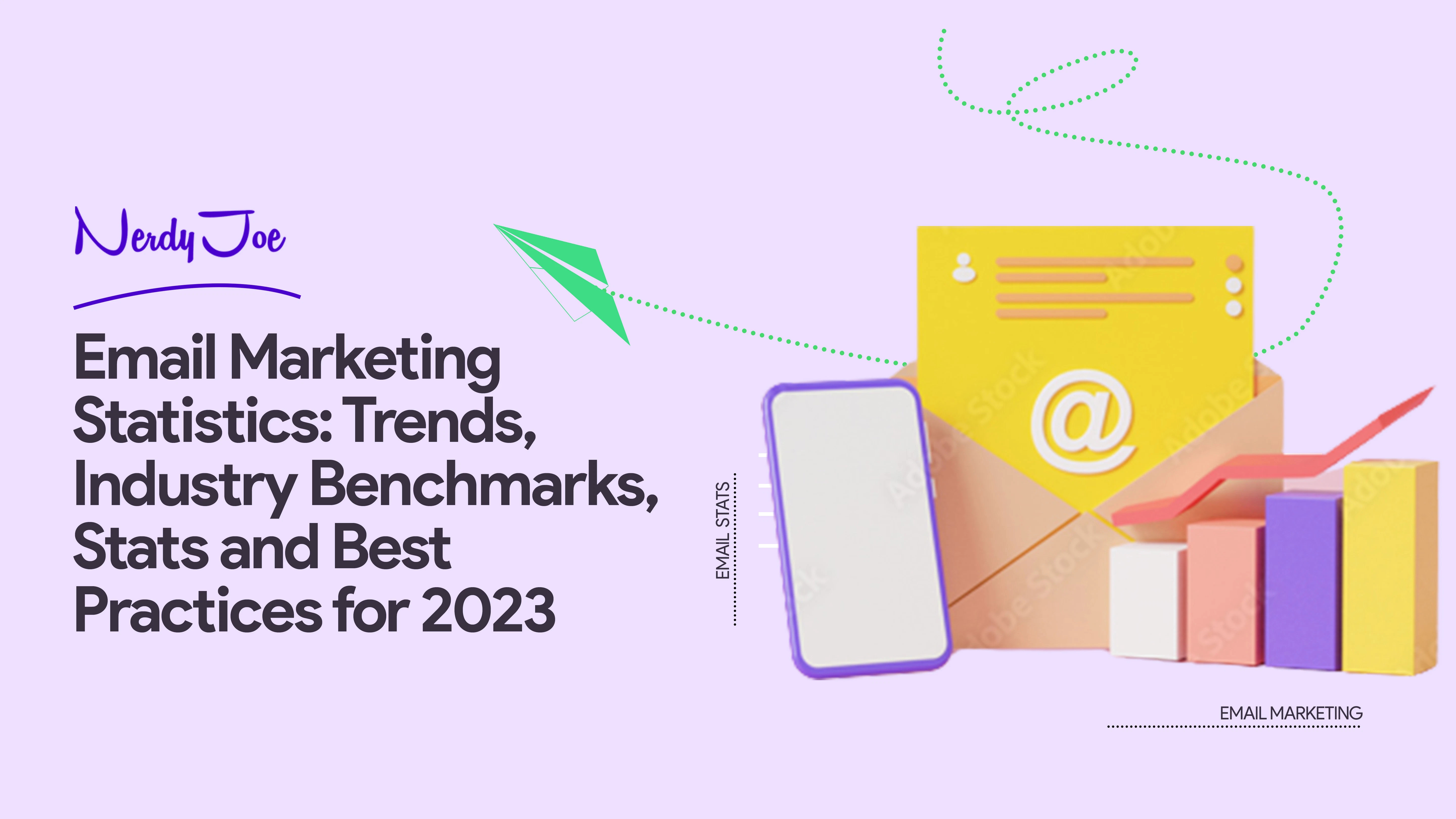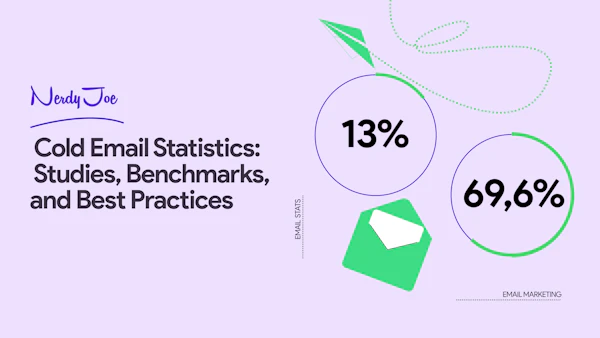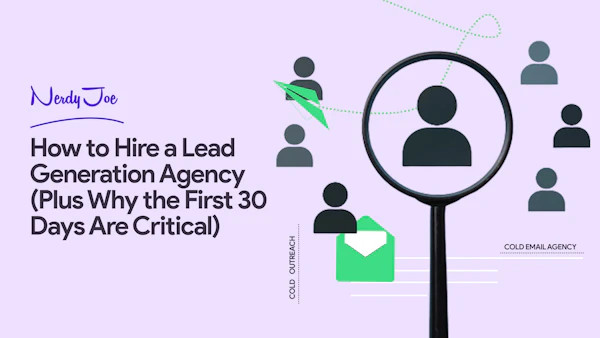Email marketing is a powerful tool for businesses of all sizes. It’s a cost-effective way to reach a large audience, build brand awareness, and increase sales.
But to be effective, you need to understand the current state of things and the latest email marketing statistics and trends.
In this blog post, we’ll explore the most important email marketing statistics for 2021 and beyond, including open and click-through rates, conversion rates, mobile optimization, and more.
General email marketing statistics and trends
These email marketing stats concern all areas of a digital marketing that involve email marketing and email users.
So whether you are looking for the numbers on marketing emails, personalized subject lines, or email marketing ROI, we go you covered.
General email marketing statistics: Worldwide email usage data
Each day, more than 306 billion emails are sent and received worldwide. (Statista, Daily Number of Emails Worldwide, 2021)
4 billion people use email for communications and marketing on a daily basis. This number is expected to climb to 4.6 billion by 2025. (Statista, Number of Email Users Worldwide, 2021)
The number of brands who place great importance on email marketing has increased from 41.5% in 2019 to 78% in 2020. (Litmus, Insights From the 2021 State of Email Report 2021)
Email marketing is used by 64% of small businesses to reach out to customers. (Campaign Monitor, Small Business Marketing Trends, 2021)
There is a 15.8% loss of emails resulting from spam filters or missing emails. (Email Tool Tester, Email Deliverability Test, 2022).
Email marketing statistics: Email marketing investment and ROI
Email marketing revenue is expected to reach almost 11 billion by the end of 2023. (Statista, Email Marketing Revenue, 2021)
The ROI for email marketing in the B2B industry is typically higher than in the B2C industry, with an average ROI of 3800%.
Businesses are allocated more and more money to email marketing.
A third of brands are increasing their email budgets, while just one percent are cutting it. (Litmus, Insights From the 2021 State of Email Report 2021)
Email marketing has an average return on investment (ROI) of 122%. (eMarketer).
Email marketing stats: Engagement, conversion, and preferability stats
The average open rate for emails is around 20%. (HubSpot, Email Open Rates)
The average click-through rate for emails is around 3%. (MailChimp, 2022 Email Marketing Statistics & Benchmarks)
The majority of emails are opened on mobile devices.
Over 61.9% of emails are opened on mobile devices by subscribers for checking the inboxes. (EasySendy, The Ultimate Mobile Email Open Statistics)
The average bounce rate across all industries is 9.96%. (Constant Contact, Average Industry Rates for Email, 2022)
Email is the most preferred method of business communication for users. 74% of people chose email as their preferred method of communication, and 89% email at least once every month for business or personal reasons. (SendGrid, The Future of Digital Communications)
A whopping 22 percent of email campaigns are opened within the first hour after they are sent.(GetResponse, Email Marketing Benchmarks, 2020)
Email is one of the most popular ways consumers discover coupons from brands in the U.S. (Statista, Common Ways to Find Coupons Among Consumers, 2021)
The majority of respondents (59%) say that marketing emails have influenced their purchases.(Salecycle, Essential Email Marketing Statistics, 2020)
Over 80% of people will open a welcome email, which generates 4x more opens and 10x more clicks than other types of emails. (GetResponse, Email Marketing Benchmarks, 2020)
98% of the single message autoresponder email recipients opened it, and 37% clicked on it. (GetResponse, Email Marketing Benchmark, 2020)
Marketing emails are used by 50% of people at least once a month to make a purchase. (Salecycle, Essential Email Marketing Statistics, 2020)
Email frequency
The average number of emails sent and received per day is around 121. (Radicati, Email Statistics Report).
The most popular day for sending emails is Tuesday. (Nerdy Joe, Best Time and Days for Sending Emails, 2022)
The best time to send emails is 10 AM in the recipient's time zone. (Nerdy Joe, Best Time and Days for Sending Emails, 2022)
63% of businesses reduce the frequency of emails sent to subscribers based on their levels of engagement. (Databox, Email Frequency Research, 2022)
33% of marketers send weekly emails, and 26% send emails multiple times per month. (Databox, Email Frequency Research, 2022)
Keeping your newsletters under five a week will have a positive impact on your open and click rates. (GetResponse, Email Marketing Benchmarks, 2020).
iOS data privacy changes
Data privacy changes have forced email marketers to prioritize different KPIs, which has been one of the most significant ways they have adapted. (HubSpot, Apple iOS 15 Impacting Email Marketers, 2021)
As a result of Apple's Mail Privacy Protection, 43% of marketers are changing how they measure email performance, while 24% aren't making any changes. (Litmus, Insights From the 2021 State of Email Report, 2021)
Inbox checking
99% of email users check their inbox every day, with some checking 20 times a day. Of those people, 58% of consumers check their email first thing in the morning. (OptinMonster, Email Marketing Statistics. 2020)
84.3% of consumers say they check their marketing email at least once a day. (Pathwire, 2021 Email Engagement Report, 2021)
Consumers spend an average of 10 seconds reading brand emails. (Statista, Time Spent on Brand Emails Report, 2021)
At least 40% of consumers have more than 50 unread emails. (HubSpot, Marketing Statistics, 2020)
Email marketing strategy
Recognizing a sender is the most important factor in deciding to open an email, followed by actually having the time to read an email. (Pathwire, Email Engagement Report, 2021)
Marketers take several actions to ensure accessibility when creating emails, including writing short, descriptive subject lines, clearly displaying links and buttons, and keeping paragraphs short. (Pathwire, Accessibility in the inbox Ebook, 2021)
Your email ROI will increase when you perform quality assurance, A/B testing, and spam testing. Testing your emails can increase your ROI to 28% higher. (Litmus, Email Marketing Guide on Email ROI, 2022)
Personalized emails have an open rate 29% higher than non-personalized ones. (Instapage, Personalization Statistics)
Segmented email campaigns have an open rate 14.32% higher than non-segmented ones. (MailChimp, Effects of List Segmentation on Email Marketing)
Subscriber segmentation has proven to be the most effective strategy for email marketing campaigns (78%), it is followed by message personalization (72%), and automation (71%). (HubSpot, Marketing Trends and Benchmark Report, 2021)
Subject lines with fewer than 50 characters have the highest open rates, while subject lines with more than 50 characters tend to have lower open rates. (UpLandSoftware, Shorter Subject Lines, Better Results, 2022)
Segmented emails have a 14.32% higher open rate and a 100.95% higher click-through rate than non-segmented emails. (MailChimp, Effects of List Segmentation on Email Marketing)
Emails with video have an open rate 49% higher and a click-through rate 65% higher than emails without video. (Campaign Monitor, Average Click-Through Rate (CTR) from Videos?, 2021)
75% of email revenue is generated from triggered personalized campaigns, rather than one-size-fits-all campaigns. (DMA, National client email report)
50% of SMBs use marketing automation software to send automated email drip campaigns. (Statista, Leading Marketing Automation Software, 2021)
A whopping 87% of B2C marketers use automation for email marketing. (HubSpot, Marketing Strategy & Trends Report, 2021)
Email, along with social media marketing and the organization's website, is used by 79% of B2C marketers to distribute content effectively. (Content Marketing Institute, Benchmarks, Budgets, and Trends, 2019)
The most commonly used type of email is automated emails, like welcome emails, used by 58% of B2C marketers. (Content Marketing Institute, Benchmarks, Budgets, and Trends, 2019)
Email subject lines statistics
47% of email recipients open email based on the subject line whereas 69% of email recipients report email as spam based solely on the subject line. (Invespcro, Email Subject Lines – Statistics and Trends, 2021)
33% of email recipients open emails because of catchy subject lines. (OptinMonster, Email Subject Line Statistics, 2020)
64% of consumers make a decision to open abandoned cart emails based on subject lines. (Barilliance, Abandoned Cart Email Subject Lines, 2021)
A/B testing their subject line helped Skandium to increase their CTR by 26.96%. (Barilliance, Abandoned Cart Email Subject Lines, 2021)
47% of marketers A/B test their subject line before finalizing their emails and sending them out. (HubSpot, Tips to Write Email Subject Lines, 2019)
Eighty-two percent of marketers send emails with subject lines under 60 characters.(Convince & Convert, Email Marketing Stats, 2020)
Email usage by generation
A majority of Millennials (59%) and Generation Z (67%), respectively, use their smartphones to check their email. (Bluecore, 2021)
Among Baby Boomers, 74% think email is the most personal channel for brands to reach out to them, followed by 72% of Generation Xers, 64% of Millennials, and 60% of Generation Zers. (Bluecore, 2021)
B2B email marketing campaign engagement stats and industry benchmarks
Average email open rates by industry
The average email open rate is one of the most important email marketing statistics to track.
It indicates the percentage of people who opened your email marketing campaign out of the total number of people who received it.
Tracking and analyzing your own email open rates over time allows you to get a better understanding of how your campaigns are performing and to identify areas for improvement.
The average open rate for marketing emails is around 20%.
However, this can vary widely depending on your industry, the quality of your email list (email subscribers), the email subject lines, sender reputation, your email marketing software and many other factors.
Here is a general overview of email open rates by industry:
Retail: 20-30%
Finance: 15-25%
Healthcare: 20-30%
Technology: 20-30%
Nonprofit: 20-30%
Travel: 20-30%
Education: 20-30%
Keep in mind that these are just rough estimates, and your own open rates may differ significantly.
To increase your open rate, make sure to segment your email list, use catchy and personalized subject lines, and send emails at the right time.
Make sure to get all the technical stuff (such as SPF, DKIM, and DMARC.) set up and right.
Also, always optimize your emails for mobile device (for smartphone users) since most emails are read on those devices.
Or, you can look at your existing customers to see which device they use the most and optimize accordingly.
Average email click-through rates by industry
The click-through rate (CTR) is the percentage of people who clicked on a link in your email out of the total number of people who received it.
The click-through rate mainly tells you how convincing or compelling your email is and how interested your recipients are in discovering more or simply at taking on your call to action.
And so, your email CTR may vary based on factors such as the quality and relevance of your content, the effectiveness of your subject line, the segmentation and personalization of your email list, and the frequency of your email sends.
The average CTR for business emails is around 2.5%. Here is the average email click-through rates by business industry:
Retail: 3.29%
Healthcare: 2.5%
Finance: 2.3%
Business Services: 2.3%
Travel and Hospitality: 2.3%
Manufacturing: 2.3%
Non-Profit: 2.1%
Technology: 1.9%
Education: 1.9%
A few tips to increase your CTR, make sure to use clear and compelling calls to action, design eye-catching emails, and segment your email list.
Average email conversion rates by industry
Conversion rate is the percentage of people who took a desired action (such as making a purchase or signing up for a newsletter) out of the total number of people who received your email.
Tracking and analyzing your conversion rate can tell you what works best for your business.
You can easily understand whether or not your email marketing strategy is working and improve it.
The average conversion rate for business emails is around 1%.
Some industries may have higher conversion rates due to the nature of their products or services and the target, while others may have lower conversion rates.
For example, selling to B2B professionals is more complex and takes longer as it requires multi-stage marketing strategies and involves multiple decision makers.
Here are some general conversion rates by industry:
E-commerce: 2-3%
Healthcare: 2%
Finance: 1-2%
Technology: 1-2%
Retail: 1-2%
Travel: 1-2%
Education: 1-2%
Note that actual conversion rates may vary significantly.
A few of the best practices you can follow to increase your conversion rate include making sure to use targeted and personalized emails, offering incentives and promotions, and optimizing your landing pages for conversions.
Average email bounce rate by industry
Email bounce rate is a measure of the percentage of emails that are not delivered to the intended recipient's mailbox.
There are two types of email bounces: hard bounces and soft bounces.
Hard bounces are permanent failures, meaning that the email cannot be delivered because the email address is invalid or the recipient's mailbox is permanently unavailable.
Soft bounces are temporary failures, which can occur for a variety of reasons, such as the recipient's mailbox being full or the email server being down.
Here are some general statistics on email bounce rates by industry:
| Industry | Hard Bounce | Soft Bounce |
|---|---|---|
| Business and Finance | 0.43% | 0.55% |
| E-Commerce | 0.19% | 0.26% |
| Education and Training | 0.32% | 0.51% |
| Health and Fitness | 0.30% | 0.40% |
| Marketing and Advertising | 0.44% | 0.68% |
| Non-Profit | 0.33% | 0.49% |
| Real Estate | 0.38% | 0.56% |
| Retail | 0.22% | 0.32% |
| Travel and Transportation | 0.31% | 0.51% |
Source: MailChimp
If you need to troubleshoot a high bounce, you can regularly clean and update your email list, use double opt-in to confirm email addresses, and ensure that your emails are properly formatted and adhere to best practices for email deliverability.
Average unsubscribe rate
The unsubscribe rate refers to the percentage of recipients who request to or opt out of your mailing list after receiving your emails.
A high unsubscribe rate generally means that people are not interested in what you send them or that you need to improve your email copy.
The average unsubscribe rate for business emails is around 0.1%.
Here are some general statistics on email unsubscribe rates by industry:
E-commerce: 0.1%.
B2B: 0.2%.
Nonprofits: 0.1%.
Media and publishing: 0.2%.
Education: 0.1%.
Healthcare: 0.1%.
Financial services: 0.2%.
Travel and hospitality: 0.1%.
Retail: 0.2%.
Real estate: 0.1%.
To reduce your unsubscribe rate, make sure to send targeted and relevant emails, and give subscribers the option to customize their email preferences.
Also, segment your audience and improve the quality of your offers.
Average email spam rates by industry
Spam rates are the percentage of emails that are marked as spam out of the total number of emails sent.
It's difficult to provide specific spam rate statistics by industry. However, in general, spam rates for email campaigns tend to range from 0.1% to 2%.
Also, spam rates in the financial, service, marketing industries tend to be high.
It's important to note that spam rates above 2% can be a red flag for ISPs (Internet Service Providers) and may result in the sender's emails being flagged as spam or blocked.
So always practice email list hygiene, follow best practices for email marketing, such as obtaining permission from recipients before sending emails, and avoiding spam language and tactics.
Key takeaways
From promotional emails, transactional emails, or triggered emails, there are many ways you can successfully use email marketing for effective customer engagement. Email marketing is a powerful tool for businesses of all sizes.
It's the most effective marketing channel and digital marketing strategy when it comes to customer acquisition and customer retention. Many marketers and small business owners have grown their business and online store on the back of email marketing.
Remember that while these email marketing statistics provide valuable insights, they’re not one-size-fits-all. Different industries and businesses will have different average open, click-through, and conversion rates. It’s important to track your own email marketing metrics and use them to optimize your campaigns and improve your results.
The main factors that will impact your email marketing statistics include the quality of your email list, the relevance of your content, your segmentation and personalization efforts, the design and layout of your emails, and more.
Make sure to focus on building a targeted email list, creating high-quality content, and optimizing your emails for conversions. With the right strategy, you can use email marketing to effectively reach and engage your audience and drive sales.




